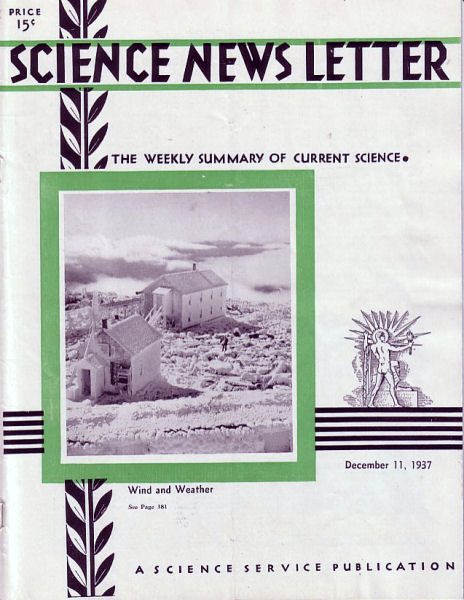From the December 11, 1937, issue

NEW OBSERVATORY CAN STAND 200-MILE-AN-HOUR WINDS
After 5 years in the stage office of the Mount Washington Auto Road Company, the famous weather observatory on the summit of this stormy mountain has just moved into a building of its own.
By direction of Col. Henry N. Teague, president of the Mount Washington Railway Co., an extraordinarily sturdy building has been constructed. People who have ridden on the cog railroad have noted the size of the timbers making up the trestle on Jacob’s Ladder and elsewhere—9 x 10 inches and 24 feet long. These same timbers when replaced have been cut to 22 feet and mortised for the framework of the new building.
It is probably safe to say that nowhere in the United States is a frame building of more solid construction to be found.
The observatory wants to take no chances of being blown away if another 200 mile-an-hour wind comes along! In such a wind in April 1934, the Stage Office danced about as much as its heavy chains would permit, and its walls now and then bellowsed in and out. The pressure inside the building varied between gusts by 0.2 inch on the barometer. This is the equivalent of a change of pressure of a ton on the surface of the building in the course of a few seconds.
Mt. Washington, highest peak in the northeastern United States and therefore a mecca for summer tourists and hikers, has had many buildings erected on its summit during the course of the last century. Every one of the old-timers with the exception of Tip Top House burned down in the great fire of 1908. Two of them blew down. Today, most of the buildings atop the peak are chained down.
ITALIAN TOMB CLEARED OF BEING FRAUD AFTER 9 YEARS
An Italian marble tomb, long suspected by critics of being an art fake palmed off on America, has been proved an authentic treasure, after 9 years of scientific testing.
At the Boston Museum of Fine Arts, where the tomb aroused such violent controversy that it was removed from public exhibition, the case is settled.
Reporting its verdict, the museum calls the tomb a fifteenth-century monument of Tuscan workmanship, later restored in minor ways. A beautiful figure of a woman lying with folded hands is a feature of the monument.
Scientific tests included making paper-thin slices of samples from all 14 pieces of marble in the tomb. These samples were studied under the microscope and compared with similar samples of known kinds of marble. This test, like that of human fingerprints, is consider unmistakable. The tomb is of two kinds of marble, the famous Carrara marble and some from Olympia. Chisel marks were also examined by microscope, and ultraviolet tests were made.
The crystalline structure of the marble’s surface was also studied, because scientists have learned that old marbles “breathe,” that is, take in and give out air. In long years, this process leaves evidence in dark bands on the marble surface, visible through the microscope. This evidence of time and weathering was found on all parts of the tomb except where a new inscription was added, and a few restorations made.
MYSTERIOUS COSMIC RAYS PIERCE 1,600 FEET OF ROCK
Scientists studying the still-mysterious and piercing cosmic rays that continually strike the Earth and everything on it, from the depths of outer space, are adventurers. They have climbed rugged mountain peaks, carried their instruments high into the stratosphere in balloons, sailed the seven seas, and sunk their equipment deep in lakes.
Now, it is disclosed at the meetings of the American Physical Society in Chicago, they have donned miners’ crash helmets and carried their delicate measuring apparatus into deep mines.
V.C. Wilson of the University of Chicago reported to the physicists’ meeting his experiments carried out in a mine in Michigan to a depth of 1,600 feet.
At this great depth, the intensity of the cosmic radiation was only one twenty-thousandth of that at the surface of the Earth. So deep was the penetration that electrons and photons fail to account for the observations, although they predominate in the Earth’s atmosphere.
It is believed these experiments provide evidence that the newfound “heavy” electron, or else the much-mentioned but yet undiscovered neutrino, is the causative agent of the piercing rays.







